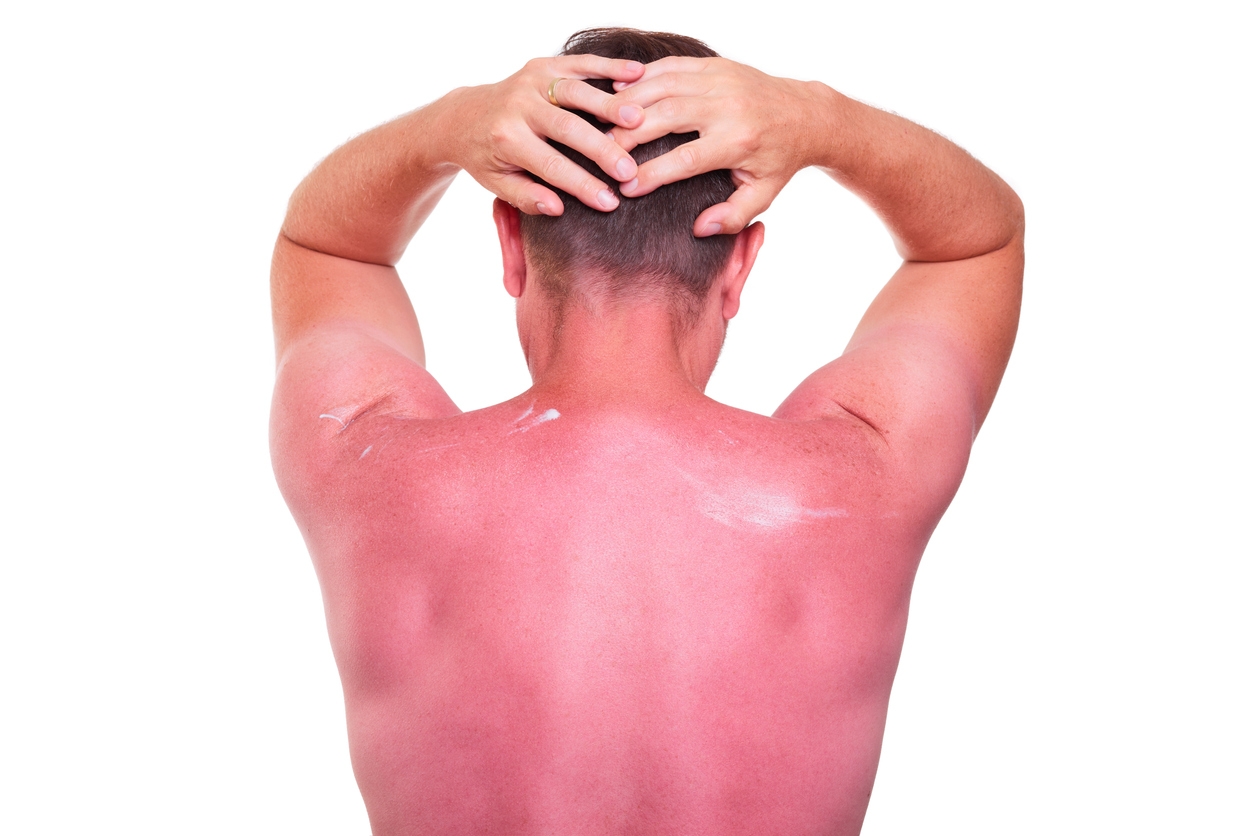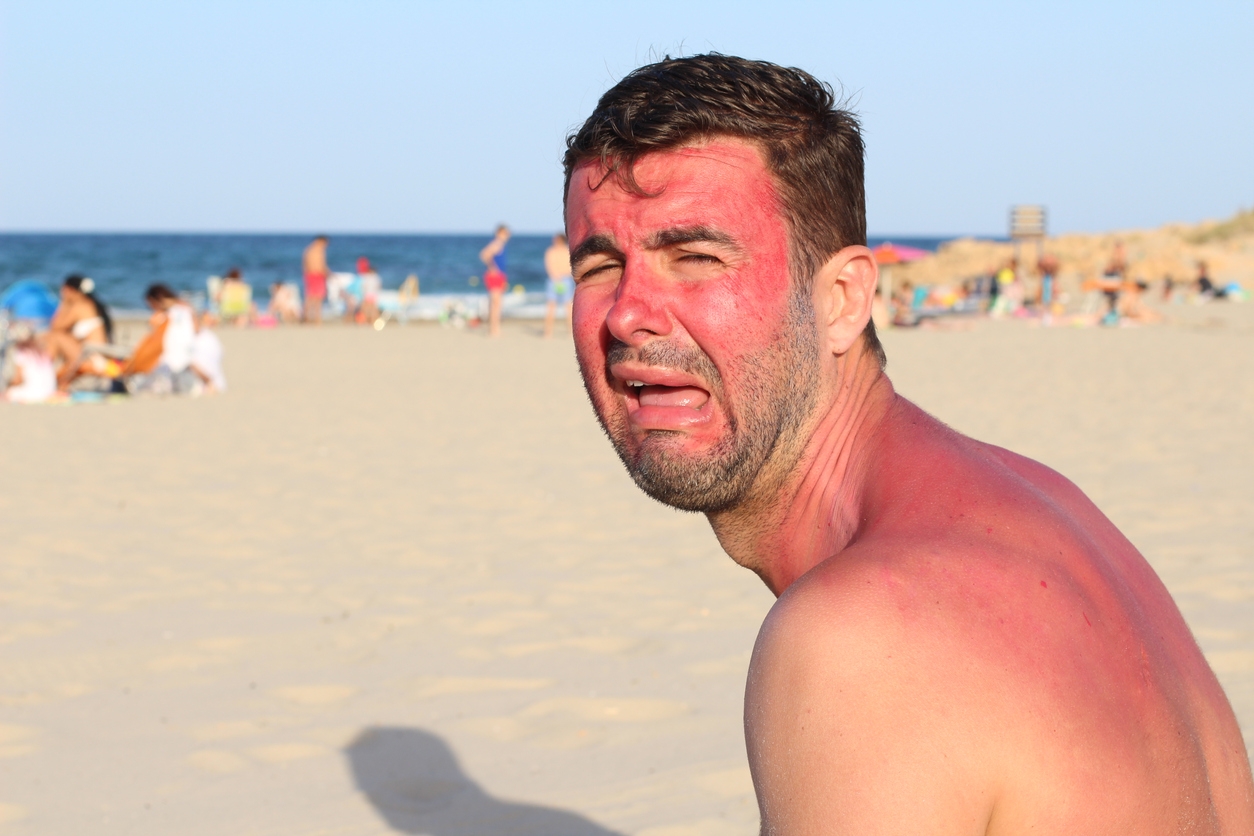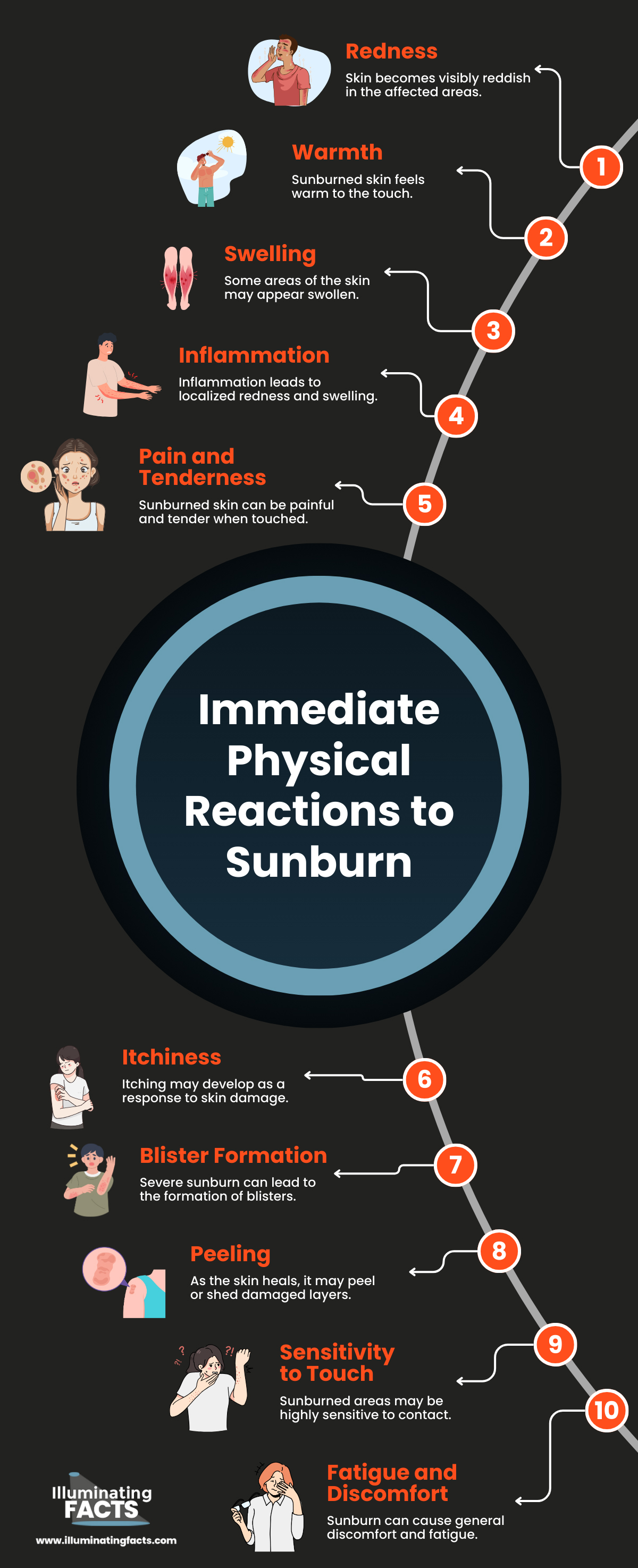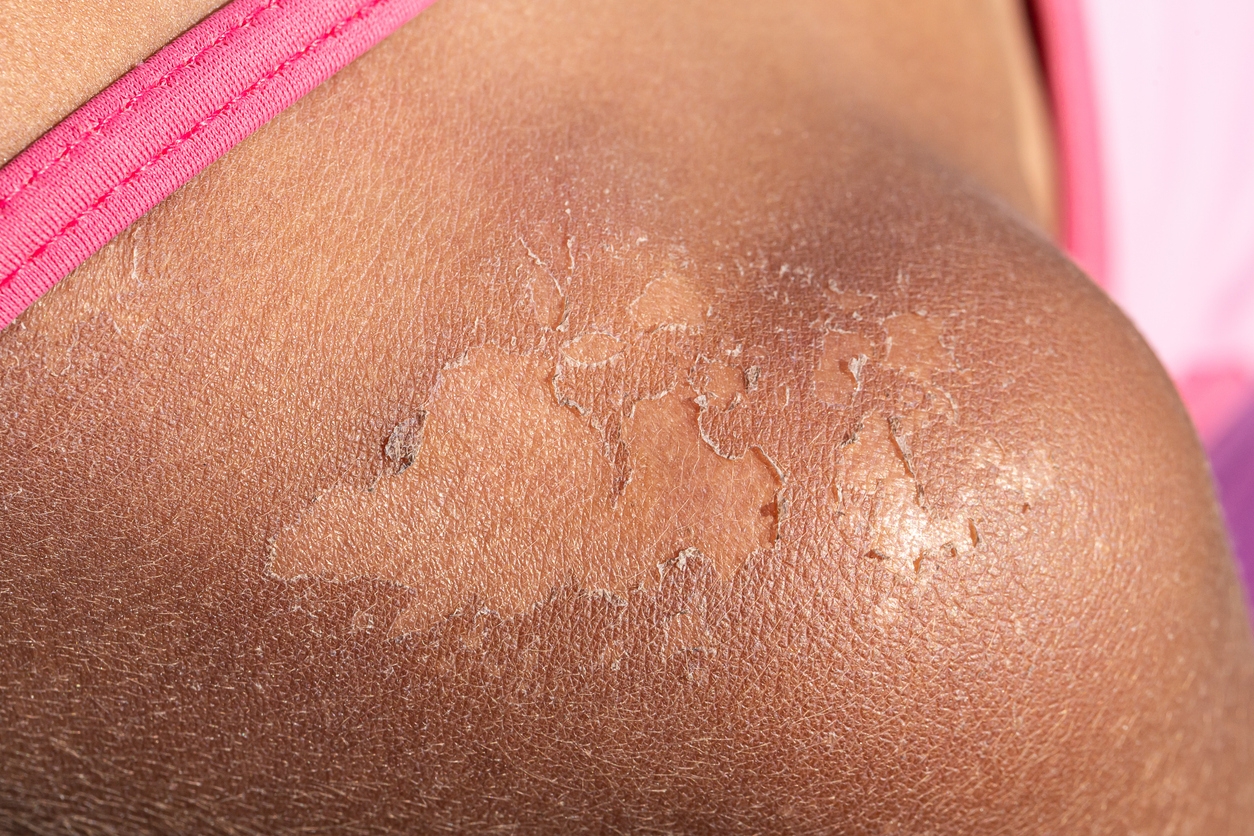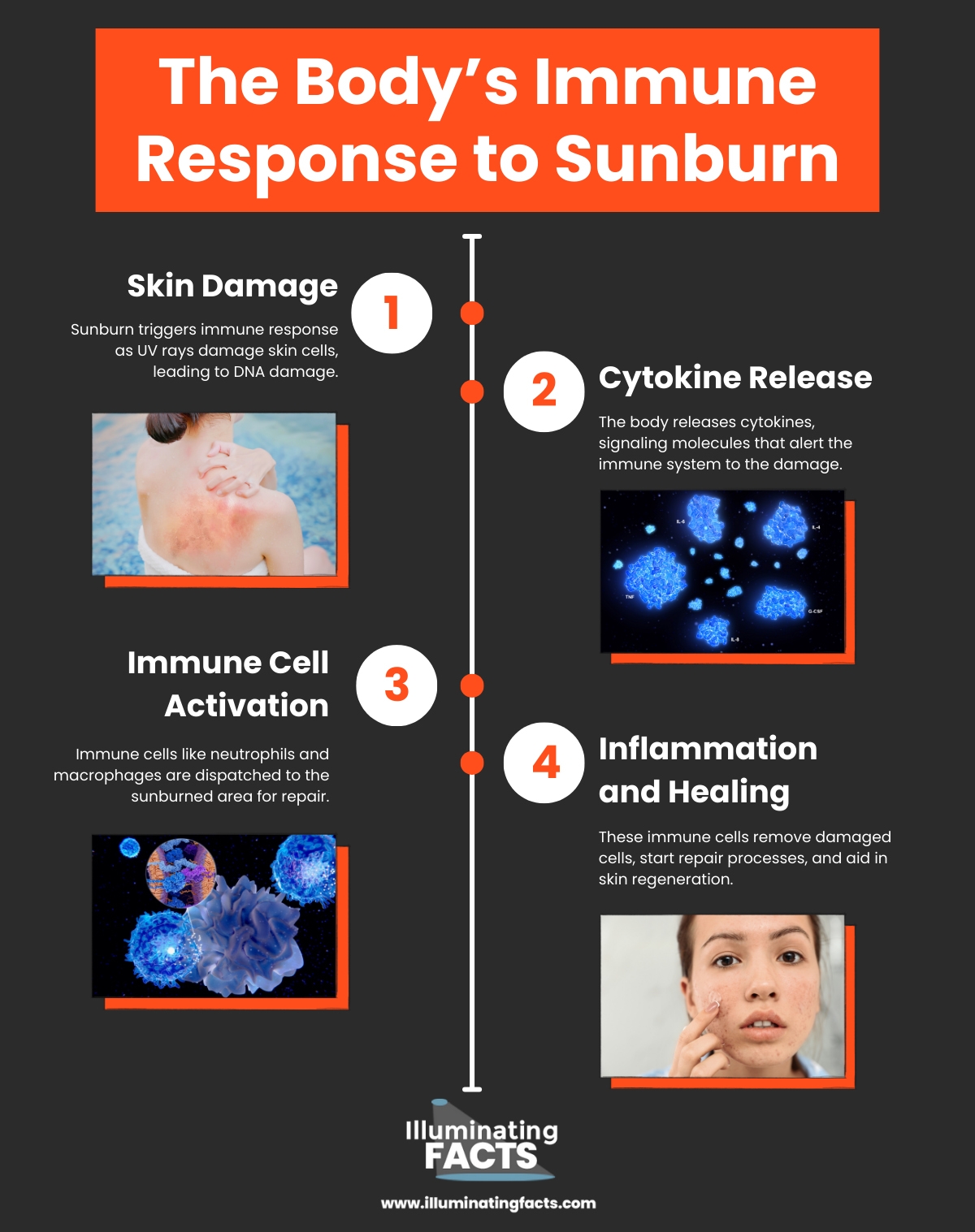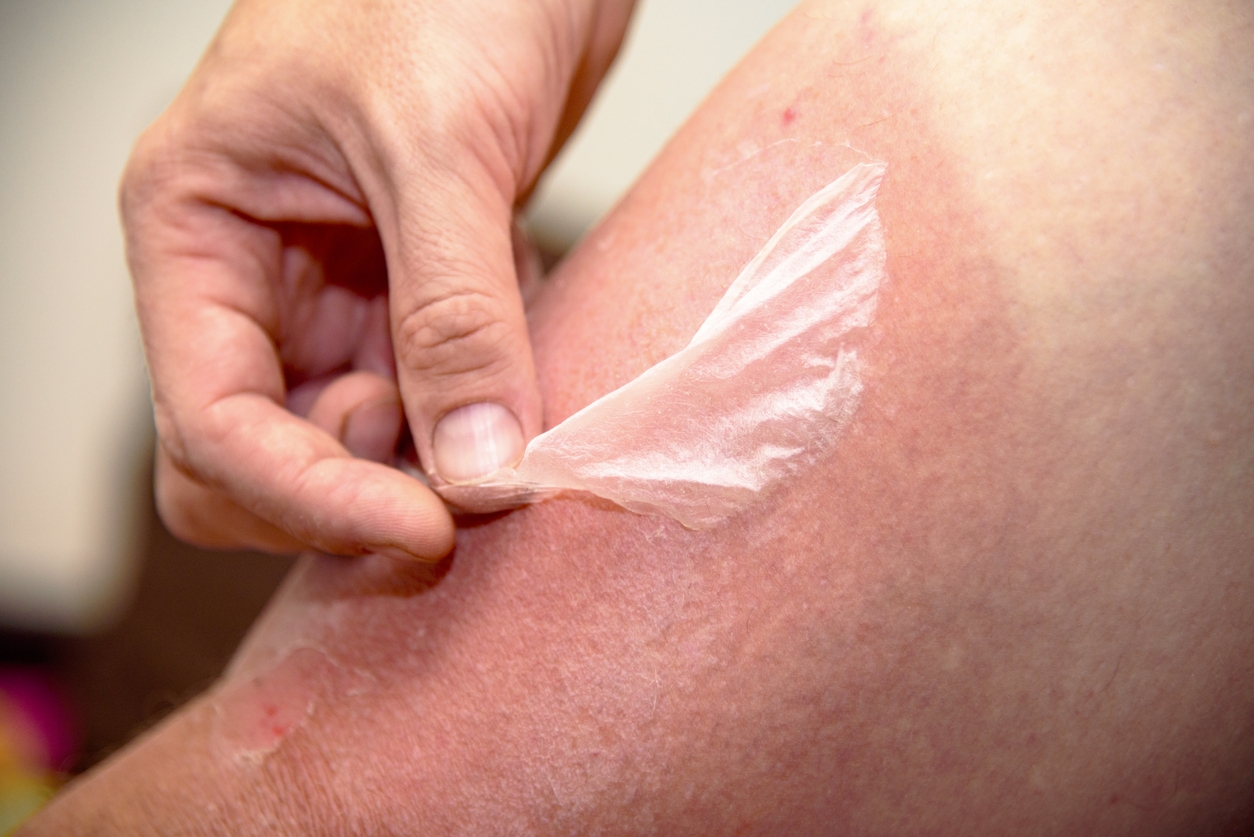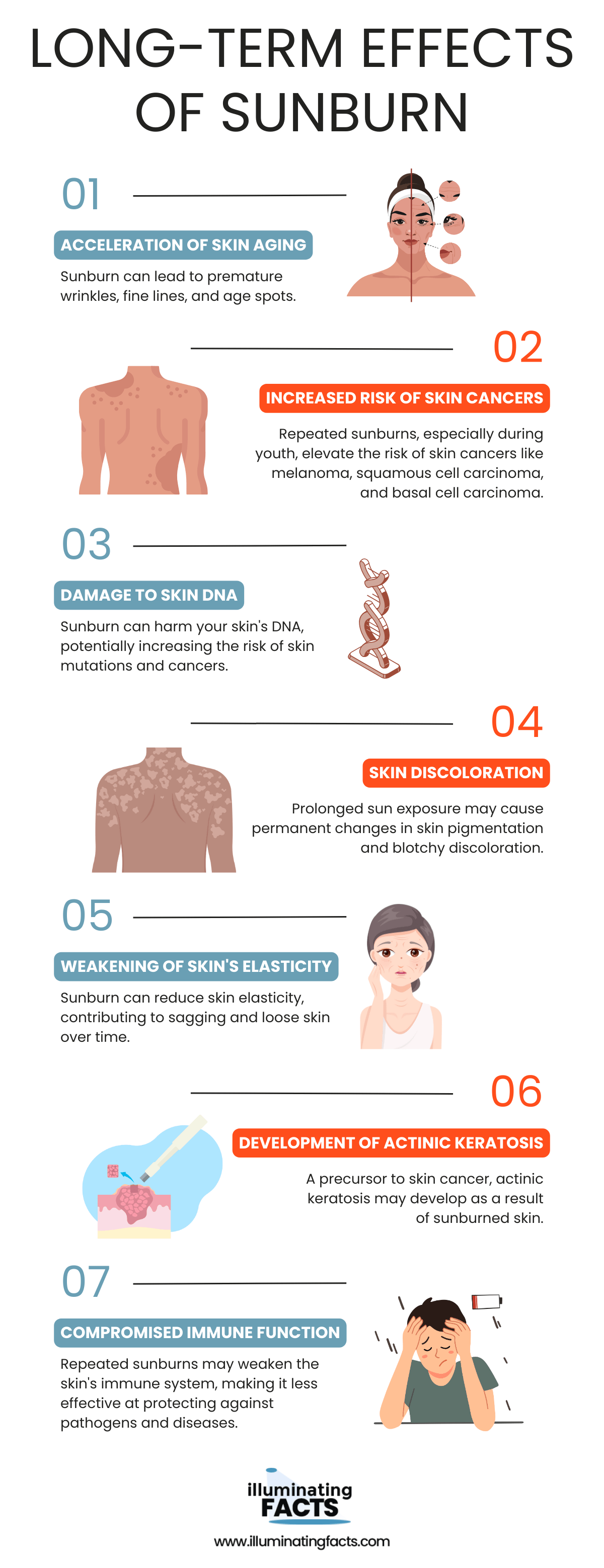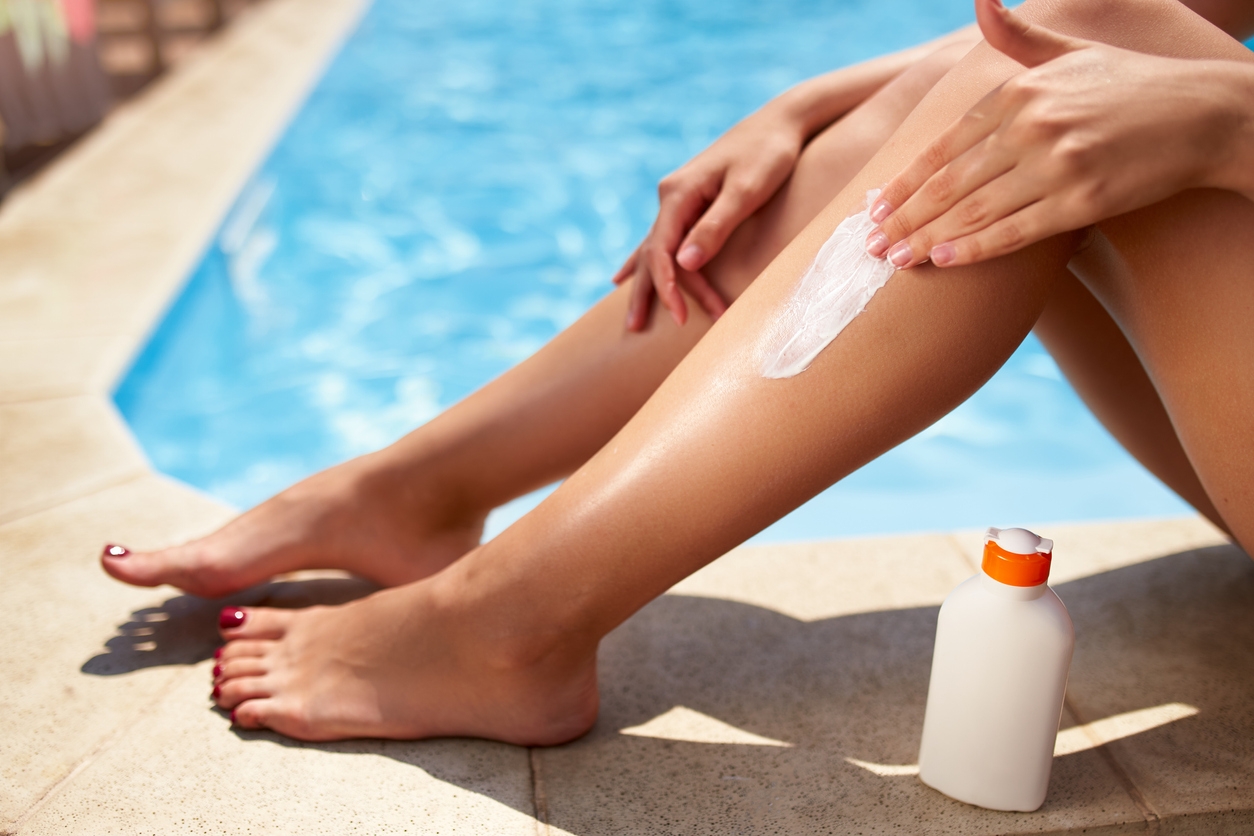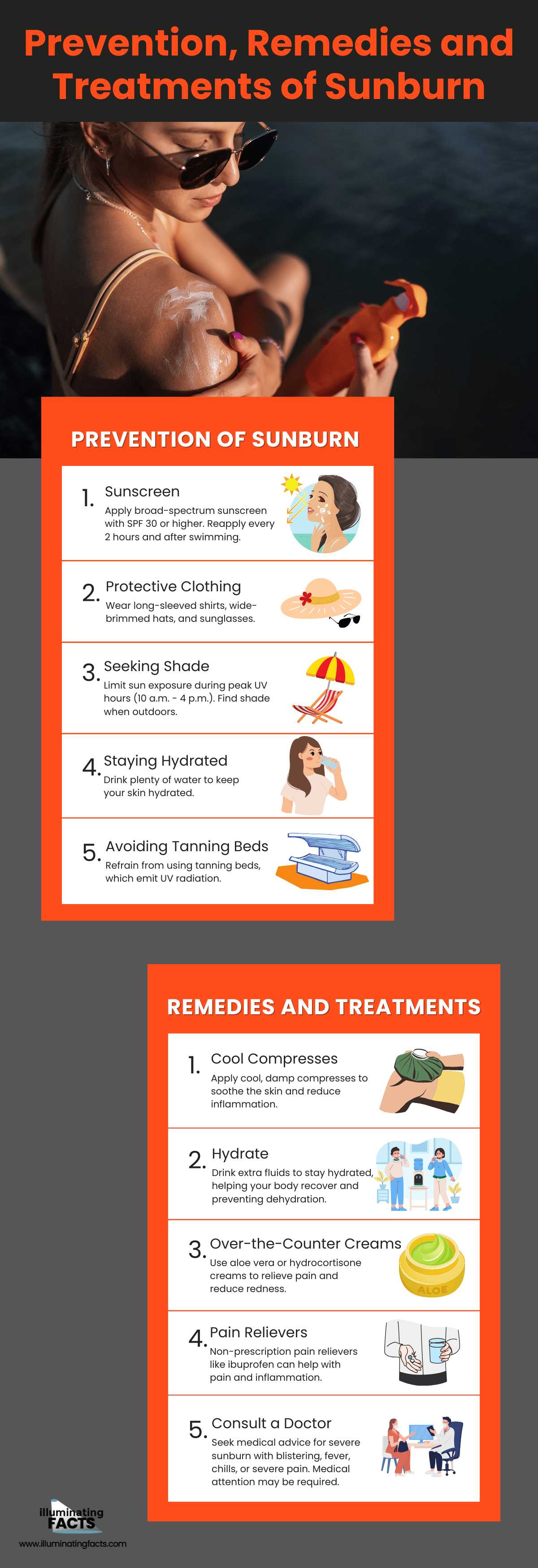Sunburn is a common skin condition that occurs when the skin is overexposed to the sun’s harmful ultraviolet (UV) radiation. It is more than just an uncomfortable sensation; it carries both immediate discomfort and long-term health risks. Understanding sunburn and its effects is essential in maintaining skin health and preventing the potentially serious consequences of excessive sun exposure.
This post takes a deep dive into the science behind sunburn, its causes, the effects on the skin, and measures to prevent and treat it effectively. So, let’s explore this crucial aspect of skincare to ensure a safer and sun-kissed future.
The Science Behind Sunburn
Sunburn is the result of overexposure to ultraviolet (UV) radiation, which can come from either the sun or artificial sources like tanning beds. [1] UV radiation has different rays, including UVA and UVB rays. When the skin is exposed to these rays for extended periods, it can lead to damage at the cellular level.
Role of Ultraviolet (UV) Rays in Causing Sunburn
Aspect | UVA Rays | UVB Rays |
Source | Present in sunlight throughout the day | Most intense during midday |
Penetration | Penetrates deeper into the skin | Primarily affects the skin's surface |
Immediate Effects | Less likely to cause immediate redness | Causes redness and sunburn |
Long-term Effects | Contributes to premature aging, wrinkles | Linked to skin cancer development |
Role in Sunburn | Less responsible for sunburn | Main cause of sunburn |
Protection Needed | Requires protection to prevent long-term damage | Requires protection to prevent sunburn |
Common Activities | Often associated with tanning beds | More likely to cause sunburn when outdoors |
UVB rays are primarily responsible for causing sunburn. [2] When these rays penetrate the outer layer of the skin (the epidermis), they interact with the DNA within skin cells. This interaction triggers a series of events, including the release of inflammatory molecules and an increase in blood flow to the affected area. As a result, the skin becomes red, swollen, and painful, which are the classic symptoms of sunburn.
UVA rays, on the other hand, can penetrate deeper into the skin, affecting the dermis. [3] They contribute to premature aging, wrinkles, and other types of skin damage, but they are less associated with the immediate redness and pain of sunburn.
To prevent sunburn, it’s essential to protect your skin from both UVA and UVB rays. Whether you are visiting the sunniest countries in the world or merrily stepping out to run errands, use sunscreen with broad-spectrum protection, wear protective clothing, and seek shade during peak sun hours. Understanding the science behind sunburn highlights the importance of these preventive measures in maintaining healthy skin.
Immediate Physical Reactions to Sunburn
The immediate physical reactions to sunburn are the body’s responses to the damaging effects of ultraviolet radiation. Understanding these reactions is vital in recognizing the extent of sunburn and taking appropriate steps for relief and recovery. Let’s delve into the intricacies of these reactions, shedding light on why sunburned skin turns red, feels warm, swells, becomes inflamed, as we experience pain and tenderness.
Physical Reaction | Description |
Redness | Skin becomes visibly reddish in the affected areas. |
Warmth | Sunburned skin feels warm to the touch. |
Swelling | Some areas of the skin may appear swollen. |
Inflammation | Inflammation leads to localized redness and swelling. |
Pain and Tenderness | Sunburned skin can be painful and tender when touched. |
Itchiness | Itching may develop as a response to skin damage. |
Blister Formation | Severe sunburn can lead to the formation of blisters. |
Peeling | As the skin heals, it may peel or shed damaged layers. |
Sensitivity to Touch | Sunburned areas may be highly sensitive to contact. |
Fatigue and Discomfort | Sunburn can cause general discomfort and fatigue. |
Redness and Warmth
Sunburned skin often takes on a reddish hue, accompanied by a sensation of warmth. [4] This redness is a visible indicator of increased blood flow to the damaged area, a response triggered by the body’s innate defense mechanisms. The warmth is a result of the blood vessels in the affected region dilating to transport immune cells and nutrients for repair.
Swelling and Inflammation
In addition to redness, swelling and inflammation may occur. [5] Swelling is the body’s way of protecting the damaged tissue, creating a physical barrier between the injury and external elements. Inflammation, while uncomfortable, is a crucial response that helps the body remove damaged cells, initiate the healing process, and fend off potential infections.
Pain and Tenderness
Sunburned skin can become painful and tender to the touch. This discomfort arises from the heightened sensitivity of nerve endings in the affected area due to inflammation. [6] The pain and tenderness serve as warning signals, prompting individuals to take protective measures and avoid further harm to the compromised skin.
These immediate physical reactions are the body’s way of signaling that it needs care and attention to recover from sunburn. It’s essential to take sunburn seriously and provide the necessary care to prevent further damage and discomfort.
The Body’s Immune Response
When the skin experiences sunburn, the body’s immune system becomes activated. It recognizes the damaged skin cells as invaders due to the UV-induced DNA damage, initiating a defensive response.
Immune Response to Sunburn | Description |
Skin Damage | Sunburn triggers immune response as UV rays damage skin cells, leading to DNA damage. |
Cytokine Release | The body releases cytokines, signaling molecules that alert the immune system to the damage. |
Immune Cell Activation | Immune cells like neutrophils and macrophages are dispatched to the sunburned area for repair. |
Inflammation and Healing | These immune cells remove damaged cells, start repair processes, and aid in skin regeneration. |
Activation of the Immune System
Sunburn triggers the body’s immune response. When skin cells are damaged by UV radiation, the immune system recognizes these cells as abnormal and launches a defense. [7]
When your skin gets sunburned, the body’s immune system springs into action. It recognizes the damaged skin cells as foreign invaders due to the DNA damage caused by UV radiation. In response, the immune system releases signaling molecules called cytokines, which act as distress signals. This immune reaction is part of the body’s effort to repair and heal the damaged skin.
Inflammatory Response and Increased Blood Flow
One of the key components of the immune response is inflammation. The body increases blood flow to the sunburned area, causing redness and warmth. [8] This heightened blood flow carries immune cells and nutrients to the damaged tissue, aiding in the repair process. While inflammation is a crucial part of the healing process, it can also contribute to the discomfort and visible symptoms of sunburn.
Role of Immune Cells
Various immune cells, such as neutrophils and macrophages, are dispatched to the sunburned area.[9] They assist in removing damaged cells and initiating the repair process. This immune response is a crucial part of the body’s efforts to heal and restore the sunburned skin.
| Immune Cells | Function in Sunburn Recovery |
| Neutrophils | First responders, clear debris and damaged cells, initiate repair. |
| Macrophages | Engage in tissue repair, remove damaged cells and debris. |
| T Cells | Regulate the immune response, assist in tissue healing. |
| Langerhans Cells | Present antigens and assist in immune response coordination. |
| Dendritic Cells | Activate T cells, play a role in adaptive immunity. |
Understanding this immune response helps us appreciate the body’s remarkable ability to repair itself and highlights the importance of protecting our skin from excessive sun exposure to prevent sunburn and reduce the risk of long-term damage.
Cellular Damage and Repair
While sunlight is one of the amazing possibilities of renewable energy for homeowners, it also contains damaging UV radiations. When your skin is exposed to excessive UV radiation from the sun, it can lead to cellular damage. Here’s how it occurs:
| Cellular Process | Description |
| Apoptosis | Programmed cell death triggered by severe UV damage to skin cells. |
| Formation of Blisters | Protective response involving fluid-filled blisters to aid in healing. |
| Skin Peeling | Removal of damaged top skin layers, revealing healthier skin beneath. |
| Long-term Cellular Changes | Cumulative effects, including sunspots, freckles, and premature aging. |
| Risk of Skin Cancer | Increased with prolonged UV exposure due to cumulative cellular damage. |
Self-destruction of Damaged Skin Cells
When skin cells are exposed to UV radiation, they undergo a process called apoptosis, a programmed cell death. [10] This self-destruction mechanism helps eliminate severely damaged cells, reducing the risk of cancer development.
Formation of Blisters and Skin Peeling
Sunburn often leads to the formation of blisters, particularly when the damage is severe. Blisters are your body’s way of protecting the underlying skin layers. [11] They contain a clear fluid that aids in healing. After a few days, the damaged top layer of skin may peel away, revealing healthier skin underneath.
Long-term Cellular Changes
Prolonged or repeated sun exposure can lead to long-term cellular changes. This may include the development of sunspots, freckles, and premature aging signs, such as fine lines and wrinkles. [12] In severe cases, long-term exposure to UV radiation can increase the risk of skin cancer due to cumulative cellular damage.
These cellular changes and repair processes that occur after sunburn highlights the importance of protecting your skin from excessive sun exposure and applying sunscreen to prevent damage in the first place.
Long-Term Effects of Sunburn
Sunburn isn’t just a temporary discomfort, it can have lasting consequences on your skin and health. Understanding these long-term effects is crucial for making informed decisions about sun protection.
Long-Term Effects of Sunburn | Description |
Acceleration of Skin Aging | Sunburn can lead to premature wrinkles, fine lines, and age spots. |
Increased Risk of Skin Cancers | Repeated sunburns, especially during youth, elevate the risk of skin cancers like melanoma, squamous cell carcinoma, and basal cell carcinoma. |
Damage to Skin DNA | Sunburn can harm your skin's DNA, potentially increasing the risk of skin mutations and cancers. |
Skin Discoloration | Prolonged sun exposure may cause permanent changes in skin pigmentation and blotchy discoloration. |
Weakening of Skin's Elasticity | Sunburn can reduce skin elasticity, contributing to sagging and loose skin over time. |
Development of Actinic Keratosis | A precursor to skin cancer, actinic keratosis may develop as a result of sunburned skin. |
Compromised Immune Function | Repeated sunburns may weaken the skin's immune system, making it less effective at protecting against pathogens and diseases. |
Accelerated Skin Aging
Repeated sunburns accelerate the aging of your skin. [13] You may notice premature wrinkles, fine lines, and age spots, making you look older than your years.
Increased Risk of Skin Cancers
Sunburns, especially during childhood and adolescence, increase the risk of developing skin cancers. [14] These include melanoma, squamous cell carcinoma, and basal cell carcinoma.
Importance of Sun Protection
Preventing sunburn through proper sun protection measures, such as sunscreen, protective clothing, and seeking shade, is essential in minimizing these long-term risks. Taking care of your skin today can lead to healthier, more youthful skin in the future.
Prevention of Sunburn
Preventive Measure | Description |
Sunscreen | Apply broad-spectrum sunscreen with SPF 30 or higher. Reapply every 2 hours and after swimming. |
Protective Clothing | Wear long-sleeved shirts, wide-brimmed hats, and sunglasses. |
Seeking Shade | Limit sun exposure during peak UV hours (10 a.m. - 4 p.m.). Find shade when outdoors. |
Staying Hydrated | Drink plenty of water to keep your skin hydrated. |
Avoiding Tanning Beds | Refrain from using tanning beds, which emit UV radiation. |
Remedies and Treatments
Remedies and Treatments | Description |
Cool Compresses | Apply cool, damp compresses to soothe the skin and reduce inflammation. |
Hydrate | Drink extra fluids to stay hydrated, helping your body recover and preventing dehydration. |
Over-the-Counter Creams | Use aloe vera or hydrocortisone creams to relieve pain and reduce redness. |
Pain Relievers | Non-prescription pain relievers like ibuprofen can help with pain and inflammation. |
Consult a Doctor | Seek medical advice for severe sunburn with blistering, fever, chills, or severe pain. Medical attention may be required. |
Conclusion
Understanding the effects of sunburn is crucial for maintaining healthy skin and overall well-being. Sunburn is not just a temporary discomfort; it can lead to long-term consequences, including skin aging and an increased risk of skin cancers. Therefore, prevention is key. By following effective sun protection measures like wearing sunscreen, protective clothing, and seeking shade, you can significantly reduce your risk of sunburn.
In the event of sunburn, prompt remedies and treatments, such as cool compresses and staying hydrated, can alleviate discomfort and aid in the healing process. It’s important to remember that sunburn is preventable, and taking precautions against excessive sun exposure is the best defense.
References
- Sunburn – Symptoms and causes. (2022, October 8). Mayo Clinic. https://www.mayoclinic.org/diseases-conditions/sunburn/symptoms-causes/syc-20355922
- How does the sun and UV cause cancer? (2021, July 7). Cancer Research UK. https://www.cancerresearchuk.org/about-cancer/causes-of-cancer/sun-uv-and-cancer/how-does-the-sun-and-uv-cause-cancer
- What is the difference between UVA and UVB rays? (2016, July 2). University of Iowa Hospitals & Clinics. https://uihc.org/health-topics/what-difference-between-uva-and-uvb-rays
- Sunburn. (n.d.). Scottish health information you can trust | NHS inform. https://www.nhsinform.scot/illnesses-and-conditions/injuries/skin-injuries/sunburn
- Healthcentral.com. (n.d.). healthcentral.com. https://www.healthcentral.com/article/dangerous-face-swelling-sunburn
- Lewsley, J. (n.d.). Sunburn severity: First and second degree symptoms. Medical and health information. https://www.medicalnewstoday.com/articles/sunburn-severity
- What happens when we get sunburnt? (n.d.). Science Illustrated. https://scienceillustrated.com.au/blog/science/what-happens-when-we-get-sunburnt/
- Blackburn, K. B. (2019, May 10). What happens when you get a sunburn. MD Anderson Cancer Center. https://www.mdanderson.org/publications/focused-on-health/What-happens-to-your-skin-when-you-get-a-sunburn.h24Z1591413.html
- What happens to your skin when you get sunburnt? (n.d.). Cancer information and support | Cancer Council. https://www.cancer.org.au/blog/what-happens-to-your-skin-when-you-get-sunburnt
- Apoptosis. (2023, October 1). Genome.gov. https://www.genome.gov/genetics-glossary/apoptosis
- Blisters. (n.d.). Scottish health information you can trust | NHS inform. https://www.nhsinform.scot/illnesses-and-conditions/injuries/skin-injuries/blisters
- Sun-damaged skin: Photoaging, signs, causes & treatment. (n.d.). Cleveland Clinic. https://my.clevelandclinic.org/health/diseases/5240-sun-damage-protecting-yourself
- Sunburn. (2023, June 14). The Skin Cancer Foundation. https://www.skincancer.org/risk-factors/sunburn/
- Skin cancer and sun exposure. (2003, May 28). WebMD. https://www.webmd.com/beauty/sun-exposure-skin-cancer


